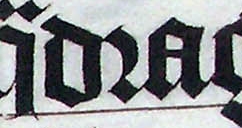
In geometry, a diameter of a circle is any straight line segment that passes through the center of the circle and whose endpoints lie on the circle. It can also be defined as the longest chord of the circle. Both definitions are also valid for the diameter of a sphere.

R or r is the 18th letter of the modern English alphabet and the ISO basic Latin alphabet. Its name in English is ar, plural ars, or in Ireland or.
Pi is the sixteenth letter of the Greek alphabet, representing the sound. In the system of Greek numerals it has a value of 80. It was derived from the Phoenician letter Pe. Letters that arose from pi include Cyrillic Pe, Coptic pi, and Gothic pairthra (𐍀).
Ø is a vowel and a letter used in the Danish, Norwegian, Faroese, and Southern Sami languages. It is mostly used as a representation of mid front rounded vowels, such as and, except for Southern Sami where it is used as an diphthong.
A ring diacritic may appear above or below letters. It may be combined with some letters of the extended Latin alphabets in various contexts.

The r rotunda (ꝛ), "rounded r", is a historical calligraphic variant of the minuscule (lowercase) letter Latin r used in full script-like typefaces, especially blackletters.
The degree symbol (°) is a typographical symbol that is used, among other things, to represent degrees of arc, hours, degrees of temperature, alcohol proof, or diminished quality in musical harmony. The symbol consists of a small raised circle, historically a zero glyph.
Ayin is the sixteenth letter of the Semitic abjads, including Phoenician ʿayin, Hebrew ʿayinע, Aramaic ʿē, Syriac ʿē ܥ, and Arabic ʿayn ع.
Unicode has subscripted and superscripted versions of a number of characters including a full set of Arabic numerals. These characters allow any polynomial, chemical and certain other equations to be represented in plain text without using any form of markup like HTML or TeX.
The copyright symbol, or copyright sign, ©, is the symbol used in copyright notices for works other than sound recordings. The use of the symbol is described by the Universal Copyright Convention. The symbol is widely recognized but, under the Berne Convention, is no longer required in most nations to assert a new copyright.
The sound recording copyright symbol, represented by the graphic symbol ℗, is the copyright symbol used to provide notice of copyright in a sound recording (phonogram) embodied in a phonorecord. Present in Europe since at least the mid-1960s, the use of the symbol in United States copyright law after 1971 was codified at 17 U.S.C. § 402 and is specified internationally in the Convention for the Protection of Producers of Phonograms Against Unauthorized Duplication of Their Phonograms.
The International Phonetic Alphabet (IPA) requires specific names for the symbols and diacritics used in the alphabet.
Unicode supports several phonetic scripts and notations through the existing writing systems and the addition of extra blocks with phonetic characters. These phonetic extras are derived of an existing script, usually Latin, Greek or Cyrillic. In Unicode there is no "IPA script". Apart from IPA, extensions to the IPA and obsolete and nonstandard IPA symbols, these blocks also contain characters from the Uralic Phonetic Alphabet and the Americanist Phonetic Alphabet.
In Unicode and the UCS, a compatibility character is a character that is encoded solely to maintain round trip convertibility with other, often older, standards. As the Unicode Glossary says:
A character that would not have been encoded except for compatibility and round-trip convertibility with other standards
The registered trademark symbol (®) is a symbol that provides notice that the preceding word or symbol is a trademark or service mark that has been registered with a national trademark office. A trademark is a symbol, word, or words legally registered or established by use as representing a company or product. In some countries it is against the law to use the registered trademark symbol for a mark that is not officially registered in any country.
Enclosed Alphanumerics is a Unicode block of typographical symbols of an alphanumeric within a circle, a bracket or other not-closed enclosure, or ending in a full stop.
Enclosed C or circled Latin C is a typographical symbol. As one of many enclosed alphanumerics, the symbol is a "C" within a circle.
Enclosed Alphanumeric Supplement is a Unicode block consisting Latin alphabet characters and Arabic numerals enclosed in circles, ovals or boxes, used for a variety of purposes. It is encoded in the range U+1F100–U+1F1FF in the Supplementary Multilingual Plane.
This page is based on this
Wikipedia article Text is available under the
CC BY-SA 4.0 license; additional terms may apply.
Images, videos and audio are available under their respective licenses.


